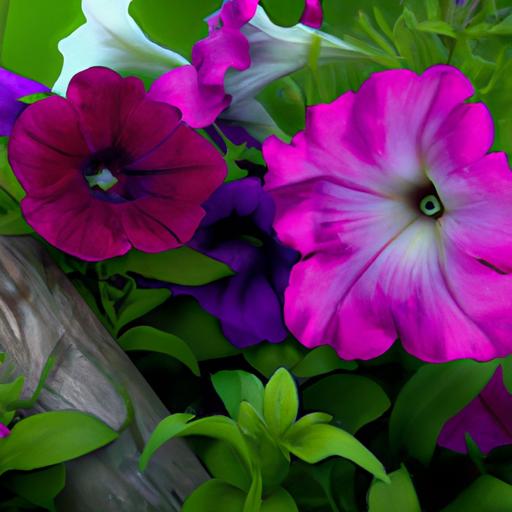If you want to take your garden to the next level, you need to know how to make your petunias spread.
Petunias are a popular flower that add vibrant color and a pleasant scent to any garden.
But to get the most out of your petunias, you need to know how to get them to spread.
In this article, we’ll go over the basics of petunias, how to deadhead them, and other tips for making them spread.
We’ll also cover how to care for them and the benefits of growing petunias.
So if you’re ready to get started, let’s dive into the world of petunias and learn how to get them to spread.
Table of Contents
Short Answer
Petunias will naturally spread over time, but to get them to spread faster there are a few steps you can take.
First, pinch off the spent flowers or deadhead the petunias to encourage the plant to produce more flowers.
This will also help them stay bushy and full.
Second, give them plenty of water and make sure the soil is well-drained.
Finally, you can divide the clumps of petunias in spring or fall to help them spread more quickly.
What Are Petunias?
Petunias are a vibrant and colorful flower that can bring life and beauty to any garden.
They are native to South America and belong to the Solanaceae family, which also includes tomatoes, peppers, and potatoes.
Petunias come in a variety of colors, from soft pastels to bright hues, and feature a showy trumpet-shaped bloom.
They are generally easy to grow and require minimal maintenance, making them a popular choice for gardeners.
Petunias are also popular in hanging baskets and window boxes, as well as in gardens.
With the right care, petunias can spread and fill in a garden bed, creating a beautiful and colorful display.
What is Deadheading?

Deadheading is a gardening practice that involves removing spent blooms from a plant in order to keep it healthy and encourage it to spread.
This process helps to promote new growth and, in the case of petunias, encourages them to spread and fill in a garden bed.
This is done by gently snipping off the dead flower heads, either with your hands or a pair of garden clippers, and then disposing of them in the compost.
This will remove the old blooms and help to stimulate new growth.
Deadheading can also help to keep petunias blooming for longer periods, as the flowers wont be able to go to seed and thus will be forced to produce more flowers.
Deadheading is a simple yet effective way to keep petunias looking vibrant and healthy.
Why is Deadheading Important for Spreading Petunias?
Deadheading petunias is an important step in ensuring that your plants spread and fill in your garden bed.
Deadheading is the process of removing spent blooms from the plant, which encourages new growth and prevents the plant from expending energy on trying to set seed.
By removing the flowers after they have faded, you are preventing the plant from setting seed and instead encouraging it to focus energy on producing more flowers.
In addition to encouraging new growth and preventing the plant from setting seed, deadheading also keeps the petunias blooming longer.
As petunias start to age, they often start to produce fewer and fewer blooms.
By regularly deadheading spent blooms, you are encouraging the plant to continue producing new blooms and extending the blooming period.
Deadheading is an easy and effective way to encourage petunias to spread and fill in your garden bed.
It not only prevents the plants from setting seed, but it also encourages new growth and keeps the petunias blooming longer.
With regular deadheading, you can have a garden full of vibrant and colorful petunias in no time.
How to Deadhead Your Petunias

Deadheading petunias is an easy and effective way to get them to spread throughout your garden. This process involves removing spent blooms from the plant, which will help encourage the petunias to produce more flowers and spread further. It is easy to deadhead petunias and only takes a few minutes. Here are some steps to ensure you have the best results:
1. Start by selecting a dry day to deadhead your petunias. This will make it easier to remove the spent blooms without damaging the petunias.
2. Gently pinch the stem of the spent bloom between your thumb and forefinger. Pinch firmly enough to snap off the stem, but be careful not to tear the petunias leaves or stem.
3. Once the stem is snapped off, you can discard it. Continue this process for all of the spent blooms on the petunia.
4. If you want to help encourage the petunias to spread even further, you can also deadhead the petunias that are starting to fade or are not blooming as much. This will help stimulate new growth and encourage the petunias to spread.
By following these steps, you can easily and effectively deadhead your petunias and encourage them to spread throughout your garden.
Not only will deadheading help your petunias spread, but it will also help them to look their best.
So, dont forget to deadhead your petunias regularly for the best results.
Other Tips for Spreading Petunias
In addition to deadheading and regular watering, there are other tips for getting petunias to spread.
First, its important to choose the right type of petunia for your garden.
Wave petunias are the most common type of petunia and theyre known for their cascading habit and ability to spread quickly.
If you want petunias to fill a large area, these are the best choice.
There are also other types of petunias, such as multiflora petunias, which have a more mounding habit and tend to stay more contained.
When planting petunias, be sure to give them plenty of space.
Petunias need room to spread out and crowding them will prevent them from doing so.
When planting in a garden bed, space petunias at least 8-12 inches apart.
Another tip for spreading petunias is to use a light mulch of compost.
This will help keep the soil cool and moist, which will encourage the petunias to spread.
Finally, be sure to prune petunias regularly.
This will help the plants stay healthy and promote more blooms.
Pruning also helps encourage the petunias to spread.
To prune petunias, simply remove any dead or damaged stems and leaves, and cut back the stems to the desired size.
With a little bit of care and attention, you can get your petunias to spread and create a beautiful and vibrant garden.
Deadheading, regular watering, proper spacing, mulch and pruning are all effective strategies for getting petunias to spread.
With the right combination of these tips, you can create a garden full of beautiful petunias in no time.
How to Care for Petunias

Caring for petunias is a simple task that can yield beautiful results.
To get your petunias to spread and fill in a garden bed, the best way to do so is to deadhead the flowers regularly.
Deadheading is the process of removing spent blooms from the plant.
This will encourage new growth and keep the petunias blooming and spreading for longer.
Additionally, be sure to water the petunias regularly, especially during dry weather, and fertilize them in the spring and summer months for best results.
When watering petunias, try to use a drip irrigation system or a watering can to ensure the water is reaching the roots of the plants.
Watering petunias from above can cause the foliage to become moldy and can increase the risk of disease.
Additionally, be sure to water petunias in the morning or evening when the temperatures are cooler.
Watering in the middle of the day can cause the water to evaporate quickly and can leave the petunias dry and prone to wilting.
Fertilizing petunias is also important for promoting healthy growth and blooms.
Use a slow-release fertilizer in the spring and summer months to provide a steady supply of nutrients to the petunias.
This will help to promote strong and healthy roots, stems, and leaves, which in turn will help to encourage more blooms.
Additionally, be sure to add a layer of mulch around the plants to help retain moisture and keep weeds at bay.
Finally, petunias do best in full sun and will need at least six hours of direct sunlight every day.
If your petunias are planted in a shady area, they may not bloom or spread as much as they would in a sunny area.
If you want your petunias to thrive, try to find a spot that gets plenty of sunlight.
With a little bit of TLC, you can have a garden full of beautiful petunias in no time.
Benefits of Growing Petunias
There are a number of reasons why petunias are a great addition to any garden.
Not only do they provide vibrant shades of color and texture, but they also attract butterflies and other pollinators.
Petunias are also relatively easy to care for, making them a great option for beginner gardeners.
They are also quite low-maintenance and can thrive in a variety of climates and soil types, making them an ideal plant for those who want a beautiful garden without too much effort.
Plus, with the right care and attention, petunias can be encouraged to spread and fill in a garden bed, creating a lush, eye-catching landscape.
Final Thoughts
Petunias are a beautiful and eye-catching flower that can bring life and color to any garden.
With a few simple steps – such as deadheading, watering, and fertilizing – you can have a garden bed filled with vibrant petunias in no time.
Not only are petunias beautiful, but they are also easy to care for and require minimal maintenance.
So don’t wait – start deadheading your petunias today and enjoy a garden full of beautiful color and life!

